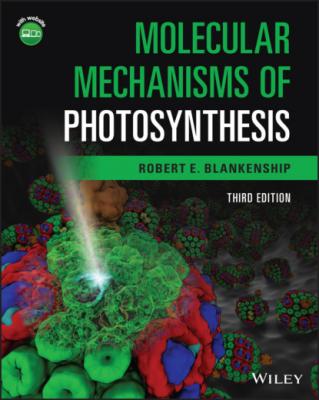Molecular Mechanisms of Photosynthesis. Robert E. Blankenship
Чтение книги онлайн.
Читать онлайн книгу Molecular Mechanisms of Photosynthesis - Robert E. Blankenship страница 29

a Purple a or b, but not both in the same species.
b Most cyanobacteria contain Chl a as their only chlorophyll‐type pigment. Prochlorophytes contain in addition Chl b. Some types also contain Chl c, d, or f.
An important variant of chlorophyll a is chlorophyll a′. This pigment differs from chlorophyll a only in the stereochemistry at the C‐132 position. It is found in small but reproducible amounts in photosystem I complexes, where one molecule forms half of P700, the special pair of pigments that is the primary electron donor (see Chapter 7). The spectral and redox properties of chlorophyll a′ are very similar to those of chlorophyll a. Current evidence suggests that chlorophyll a′ is made from pre‐existing chlorophyll a, although the putative C‐132 invertase enzyme has not been identified.
4.1.2 Chlorophyll b
Chlorophyll b is identical to chlorophyll a except at the C‐7 position, where a formyl group replaces the methyl group. This change shifts the maximum absorption to shorter wavelengths. Chlorophyll b is the major accessory light‐absorbing pigment in light‐harvesting complexes in the majority of eukaryotic photosynthetic organisms, including plants and green algae, and is not found in reaction center complexes. In photosynthetic prokaryotes, it is found only in the prochlorophytes, in some cases as divinyl chlorophyll b.
4.1.3 Chlorophyll c
Chlorophyll c is perhaps the most unusual of all the chlorophylls, in that it does not have an isoprenoid tail and also does not have ring D reduced. It is therefore chemically classified as a porphyrin, and not as a chlorin. Chlorophyll c is found exclusively in various groups of marine algae, such as diatoms and dinoflagellates. It functions as an accessory light‐harvesting pigment in pigment–protein complexes similar to those involving chlorophyll b in plants and green algae. There are several structural variants of chlorophyll c, which vary in some of the peripheral ring substituents, as shown in Fig. 4.3.
4.1.4 Chlorophyll d
Chlorophyll d is different from chlorophyll a in only one respect: the substituent at the C‐3 position is a formyl group in chlorophyll d, instead of the vinyl group found in chlorophyll a. For many years, chlorophyll d was known only as a trace constituent of certain red algae and was suspected to be an experimental artifact. However, in 1996, a cyanobacterium, Acaryochloris marina, was discovered as a symbiont in a marine animal called an ascidian. This organism contains chlorophyll d as the major pigment, although it also contains small amounts of chlorophyll a. It now appears that chlorophyll d is only found in cyanobacteria, and that earlier reports of chlorophyll d in red algae result from contamination of the algal surface by epiphytic cyanobacteria that contain chlorophyll d (Larkum and Kuhl, 2005). The electron withdrawing formyl group at the C‐3 position adjacent to the y molecular axis of the pigment has the effect of shifting the absorption maximum of chlorophyll d to longer wavelengths compared to chlorophyll a. It has therefore received attention as a possible pigment to expand the solar spectrum in bioenergy applications (Chen and Blankenship, 2011).
4.1.5 Chlorophyll e
Chlorophyll e was isolated and named provisionally in the 1940s, but the structure has never been determined and so its structure and function remain uncertain.
4.1.6 Chlorophyll f
Chlorophyll f is the most recently discovered of all the chlorophyll‐like pigments. It contains a formyl group at the C‐2 position. It was found in cyanobacterial cultures isolated from microbial structures called stromatolites (Chen et al., 2010; Chen et al., 2012), but is now known to be present in a wide range of cyanobacteria that have been grown using far‐red light (Gan et al., 2014). Similar to the case in chlorophyll d, the formyl group at the C‐2 position shifts the absorbance maximum of this pigment substantially to longer wavelengths compared to chlorophyll a.
4.1.7 Bacteriochlorophyll a
The chemical structure of bacteriochlorophyll a is shown in Fig. 4.4. It is the principal chlorophyll‐type pigment in the majority of anoxygenic photosynthetic bacteria. The chemical differences between the structures of chlorophyll a and bacteriochlorophyll a are the acetyl group at the C‐3 position and the single bond in ring B between C‐7 and C‐8, instead of the double bond found in chlorophylls. This reduces the degree of conjugation in the macrocycle and also reduces the symmetry of the molecule compared with chlorophylls. These structural changes exert major effects on the spectral properties, which are discussed below.
A few species of the purple photosynthetic bacteria have been found that use zinc (Zn) as the central metal instead of Mg in bacteriochlorophyll a (Wakao et al., 1996). These organisms are found in highly acidic environments where Mg2+ is readily displaced by H+, whereas Zn is more stable as a central metal. These are the only two metal ions that have been found incorporated into natural chlorophylls, although many other metals can be inserted synthetically into the metal‐free pigments. The reason for this specificity is probably that Mg is very readily available, whereas Zn is a trace element in almost all environments and would therefore often be a limiting nutrient. As discussed below, most other metals are unsuitable for photosynthesis, because pigments with these metals incorporated